Coal-Fired Boiler Flue Gas Desulfurization System Based on Slurry Waste Heat Recovery in Severe Cold Areas
Abstract
:1. Introduction
2. Calculation Models for the Wet Flue Gas Desulfurization System
2.1. Assumptions and Simplifications for Models
- The slurry droplet is a regular sphere with uniform particle size and the same physical parameters at the same position. The mutual friction and collision between the droplets are not considered in the process of motion.
- The countercurrent process of flue gas and droplets is sufficient, uniform and stable.
- The droplets and flue gas move at a constant speed in the process of movement.
- Ignore the interference of the existing chemical reactions on heat and mass transfer.
2.2. Model for Heat and Mass Transfer
2.3. Calculation of Heat and Mass Transfer Model
2.4. Integrated System of Desulfurization Tower and Open Slurry Pool
2.5. Model for Flue Gas Desulfurization-Waste Heat Recovery System
3. Results and Discussion
3.1. Effect of the Key Parameters in the System on Desulfurization Efficiency
3.1.1. Effect of the Reaction Zone Height on Desulfurization Efficiency
3.1.2. Effect of the Flue Gas Inlet Temperature on Desulfurization Efficiency
3.1.3. Effect of the Slurry Inlet Temperature on Desulfurization Efficiency
3.1.4. Effect of the Gas-Liquid Ratio on Desulfurization Efficiency
3.2. Effect of Working Conditions on the Integrated System
3.2.1. Effect of Wind Speed on the Integrated System
3.2.2. Effect of Heat Dissipation Area on the Integrated System
3.2.3. Effect of Ambient Temperature on the Integrated System
3.3. Effect of Working Conditions on the Heat Transfer Area
3.3.1. Effect of Wind Speed on the Heat Transfer Area
3.3.2. Effect of Heat Dissipation Area on the Heat Transfer Area
3.3.3. Effect of the Lumped Average Temperature of the Flue Gas on the Heat Transfer Area
3.3.4. Effect of Ambient Temperature on the Heat Transfer Area
3.4. Economic Feasibility Analysis
4. Conclusions
- (1)
- The mathematical and physical models were established from the liquid phase and gas phase, respectively. Through these models, five related models about Q, xg, td, tg and were determined. The numerical method was developed here to ensure the correctness and convergence of the results.
- (2)
- The desulfurization efficiency was analyzed thoroughly. The desulfurization efficiency decreases gradually along the height of the reaction zone. The smaller the initial equivalent diameter of the droplet, the greater the desulfurization efficiency. The desulfurization efficiency tends to be flat when the inlet temperature of flue gas is between 155 °C and 175 °C. When the slurry inlet temperature is lower than 40 °C, the desulfurization efficiency does not change much with the slurry temperature. When the slurry inlet temperature is higher than 55 °C, the desulfurization efficiency is highly affected by the slurry temperature change.
- (3)
- The influence of the working conditions on the desulfurization system was also discussed in detail. It can be found that the order of influence degree to the desulfurization system is as follows: the outdoor wind speed is the strongest, the surface area of the open slurry pool is the second, the average flue gas temperature is slightly weaker and the outdoor ambient temperature is the weakest.
- (4)
- The economic analysis of the desulfurization system was carried out using the annual cost method, and the comprehensive net benefit of the known year is positive, which proves the economic feasibility of the desulfurization system.
Author Contributions
Funding
Institutional Review Board Statement
Informed Consent Statement
Data Availability Statement
Conflicts of Interest
Nomenclature
| A0 | cross-sectional area of desulfurization tower, m2 |
| Aed | heat transfer area between heat exchanger and slurry, m2 |
| Agd | contact area between flue gas and slurry, m2 |
| Ai | convective heat transfer area of flue gas and slurry droplets in the i-th micro-element, m2 |
| As | area of the slurry pool, m2 |
| B | atmospheric pressure, mmHg |
| Cp,d | specific heat capacity of slurry droplet, J/(kg·k) |
| Cp,g | specific heat capacity of flue gas, J/(kg·k) |
| Cp,w | specific heat capacity of water vapor, J/(kg·k) |
| concentration of sulfur dioxide in droplets, mol/m3 | |
| Dd | slurry droplet diameter, m |
| Hx | Henry’s constant, mol/(kg∙Pa) |
| had | convective heat transfer coefficient between slurry and air, kW/(m2·K) |
| hgd | convective heat transfer coefficient between slurry and flue gas, kW/(m2·K) |
| iwa | enthalpy of wet air, kJ |
| ked | heat transfer coefficient between heat exchanger and slurry, W/(m2∙K) |
| kgd | mass transfer coefficient of water vapor, kg/(m2·s) |
| mass transfer coefficient of sulfur dioxide, m/s | |
| md | quality of slurry droplets, kg |
| N | rate of droplet production |
| partial pressure of water vapor at slurry temperature, mmHg | |
| partial pressure of water vapor at air temperature, mmHg | |
| R | Gas constant, 8314 J/(mol∙k) |
| Rd | slurry droplet radius, m |
| latent heat of vaporization of water in a slurry at a temperature of tg, kJ/kg | |
| ta | ambient temperature, °C |
| td | slurry temperature °C |
| tg | flue gas temperature °C |
| average temperature of slurry droplet, °C | |
| average temperature of flue gas, °C | |
| temperature of the slurry in the i-th micro-element, °C | |
| temperature of the flue gas in the i-th micro-element, °C | |
| ud | velocity of slurry droplet, m/s |
| ug | velocity of flue gas, m/s |
| V | wind speed on the surface of the slurry pool, m/s |
| X | reaction zone height, m |
| xd | moisture content of slurry, kg/kg |
| xg | moisture content of flue gas, kg/kg |
| Greek symbols | |
| desulfurization efficiency of sulfur dioxide, % | |
| time, h | |
| connection between convective heat transfer and total heat of slurry | |
| aggregate heat dissipation coefficient, kW/(m2·K) | |
| Subscripts | |
| a | air |
| d | slurry droplet |
| g | flue gas |
| w | water vapor |
| SO2 | sulfur dioxide |
| ag | air and slurry droplet |
| ed | heat exchanger and slurry |
| gd | flue gas and slurry droplet |
| wa | wet air |
References
- Song, Y. Research and development of low-temperature flue gas waste heat recovery system for district heating industrial boiler. Harbin Inst. Technol. 2013, 3, 90–91. [Google Scholar]
- Nengxiao, X. Analysis of energy efficiency in China. Coal Econ. Res. 2004, 9, 4–7. [Google Scholar]
- Zhu, K.; Xia, J.; Xie, X.; Jiang, Y. Total heat recovery of gas boiler by absorption heat pump and direct-contact heat exchanger. Appl. Therm. Eng. 2014, 71, 213–218. [Google Scholar] [CrossRef]
- Che, D.; Liu, Y.; Gao, C. Evaluation of retrofitting a conventional natural gas fired boiler into a condensing boiler. Energy Convers. Manag. 2004, 45, 3251–3266. [Google Scholar] [CrossRef]
- Lee, C.-E.; Yu, B.; Lee, S. An analysis of the thermodynamic efficiency for exhaust gas recirculation-condensed water recirculation-waste heat recovery condensing boilers (EGR-CWR-WHR CB). Energy 2015, 86, 267–275. [Google Scholar] [CrossRef]
- Matsui, H.; Linura, H. Treatment of incinerator flue gases with magnesium hydroxide. 1994, A2, P06–P130. [Google Scholar]
- Berman, Y.; Nklevsky, A.; Orenetal, Y. Modeling and experimental studies of SO2 absorption in coaxial cylinders with impinging streams: Part II. Chem. Eng. Sci. 2000, 55, 1023–1028. [Google Scholar] [CrossRef]
- Akiyoshi, T. Waste Gas Desulfurization Using Magnesium Hydroxide with Improved Utilization Factor of Treatment Agent. Japan Patent No. 2001179048A2, 2 July 2001. [Google Scholar]
- Koyama, H. Apparatus for Desulfurization of Flue Gases with Recycling Magnesium Oxide and Recovering Sulfur Acid. Japan Patent No. 10109013, 28 April 1998. [Google Scholar]
- Seader, J.D. The rate-based approach for modeling staged separation. Chem. Eng. Prog. 1989, 85, 41–49. [Google Scholar]
- Wang, W. Research on Gas-Liquid Mass Transfer and Reaction Characteristics in Absorption Process of Sodium-Alkali Flue Gas Desulfurization. Ph.D. Thesis, Tianjin University, Tianjin, China, 2007. [Google Scholar]
- Wang, S.; Zhao, L.; Wang, C.; Liu, Y.; Gao, J.; Liu, Y.; Cheng, Q. Numerical simulation of gas–solid flow with two fluid model in a spouted-fluid bed. Particuology 2014, 14, 109–116. [Google Scholar] [CrossRef]
- Chen, B.; Sun, F.; Gao, M.; Shi, Y. A 1-D model of spraying performance for wet flue gas desulfurization scrubber based on predicted slurry temperature. Appl. Therm. Eng. 2019, 155, 259–266. [Google Scholar] [CrossRef]
- Qiao, Z.; Wang, X.; Gu, H.; Tang, Y.; Si, F.; Romero, C.E.; Yao, X. An investigation on data mining and operating optimization for wet flue gas desulfurization systems. Fuel 2019, 258, 116178. [Google Scholar] [CrossRef]
- Qin, M.; Dong, Y.; Cui, L.; Yao, J.; Ma, C. Pilot-scale experiment and simulation optimization of dual-loop wet flue gas desulfurization spray scrubbers. Chem. Eng. Res. Des. 2019, 148, 280–290. [Google Scholar] [CrossRef]
- Zou, J. Design and Configuration of Flue Gas Desulfurization Engineering System for a 2 × 660 MW Unit; Guangdong Electric Design Institute: Guangzhou, China, 2011; Volume 22. [Google Scholar]
- Silverman, I.; Sirignano, W. Multi-droplet interaction effects in dense sprays. Int. J. Multiph. Flow 1994, 20, 99–116. [Google Scholar] [CrossRef]
- Jiangping, L. Discussion on the different forms of variables in the expression of Henry’s law. Liaoning Chem. Ind. 2014, 43, 1515–1516. [Google Scholar]
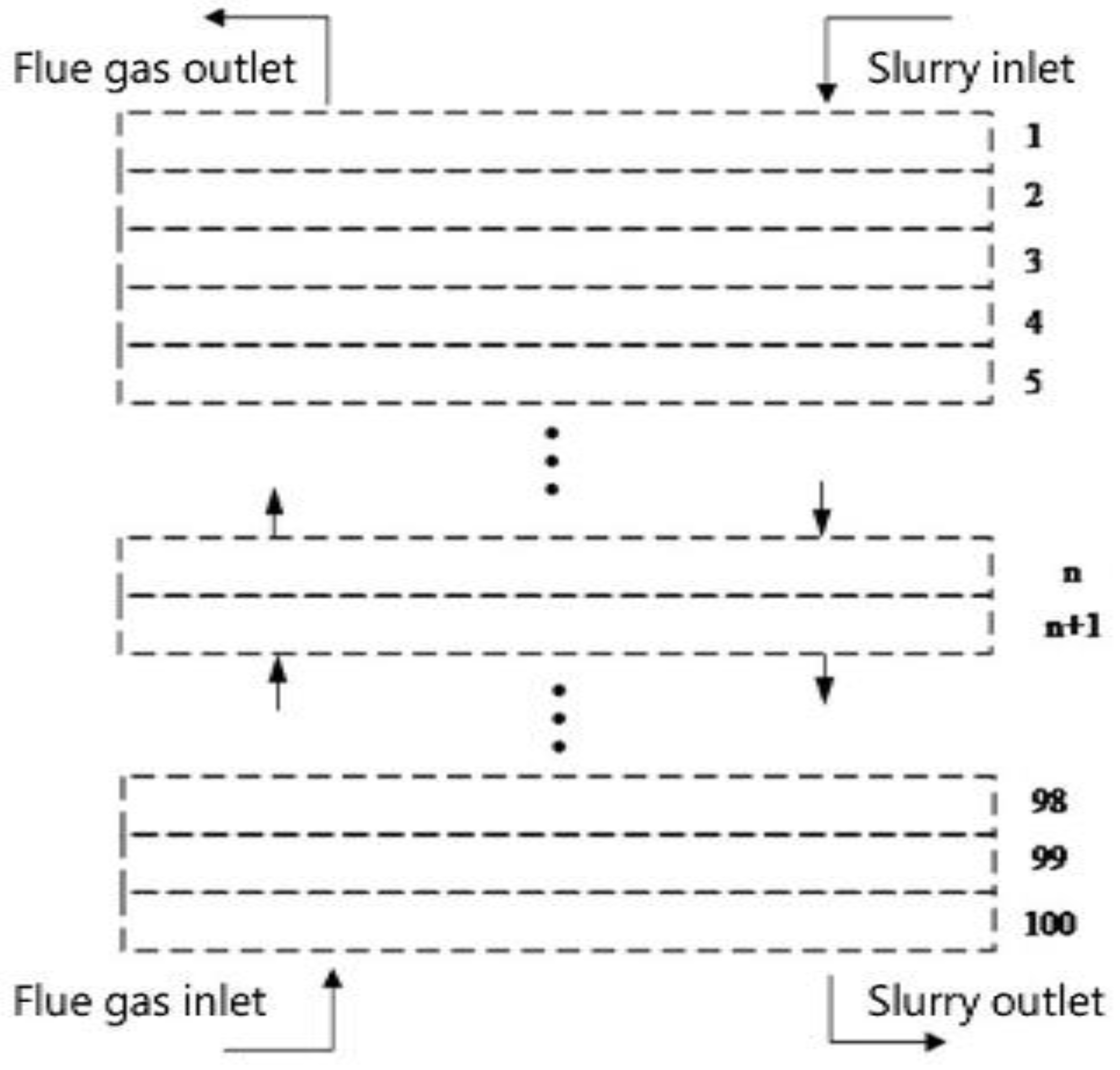
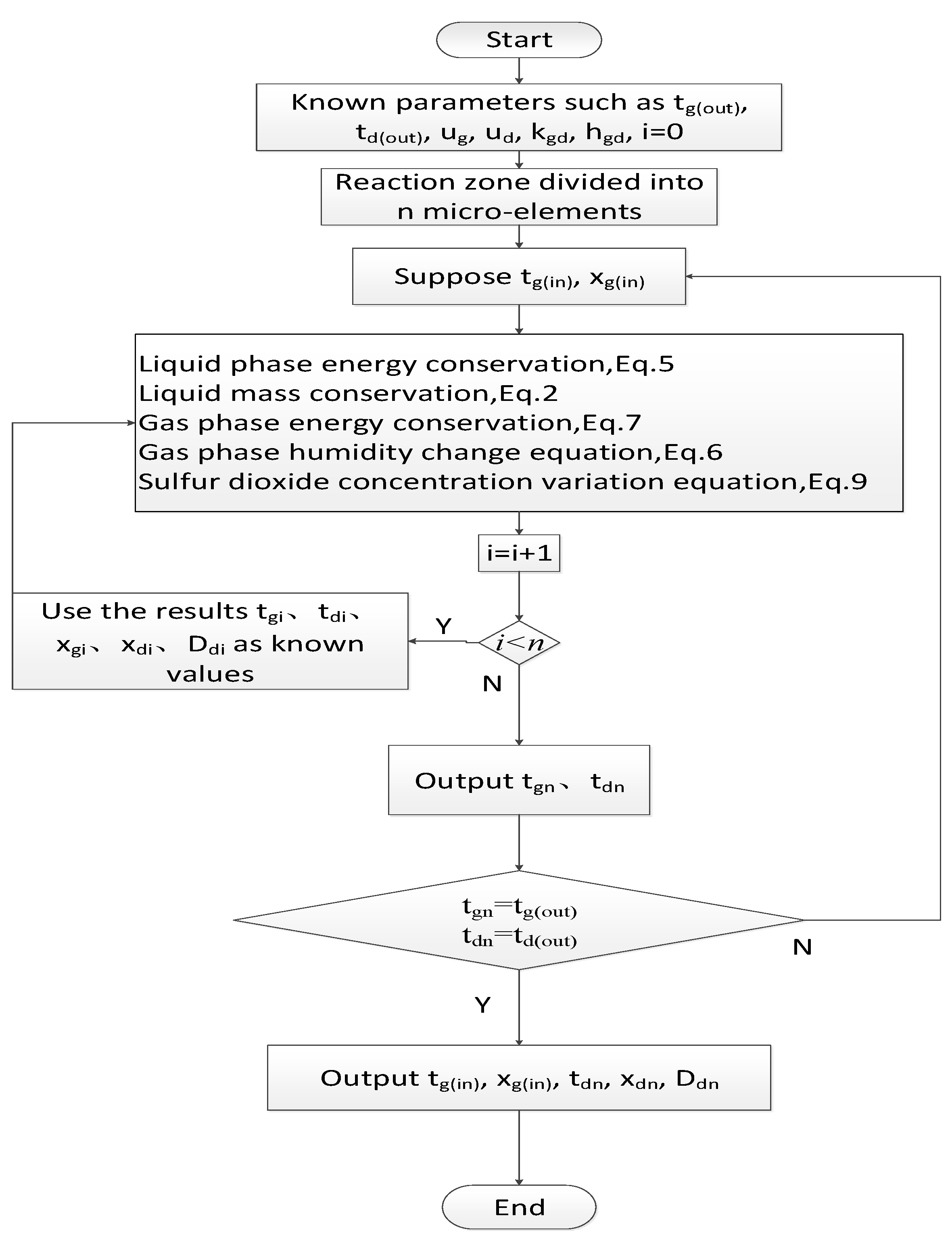



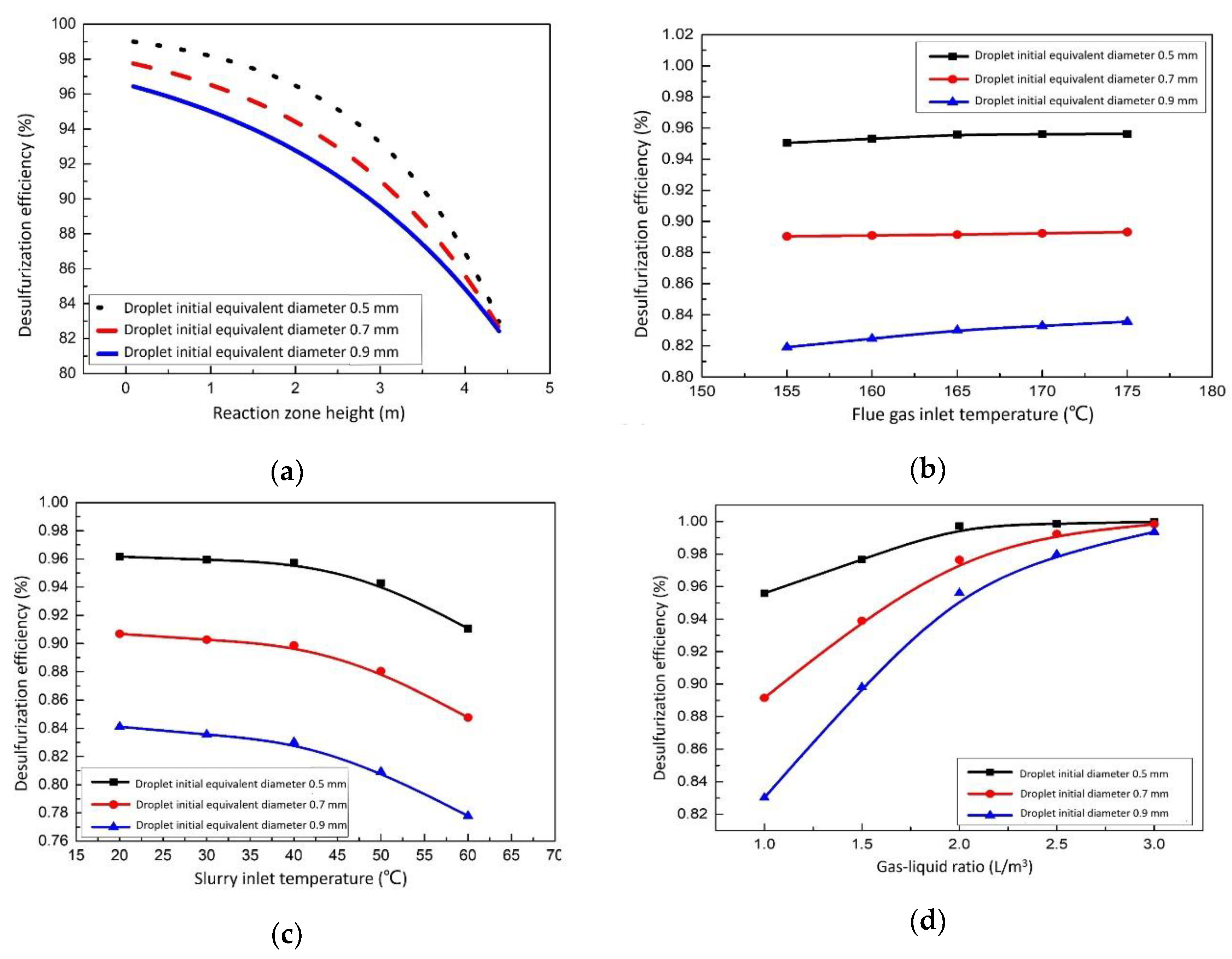
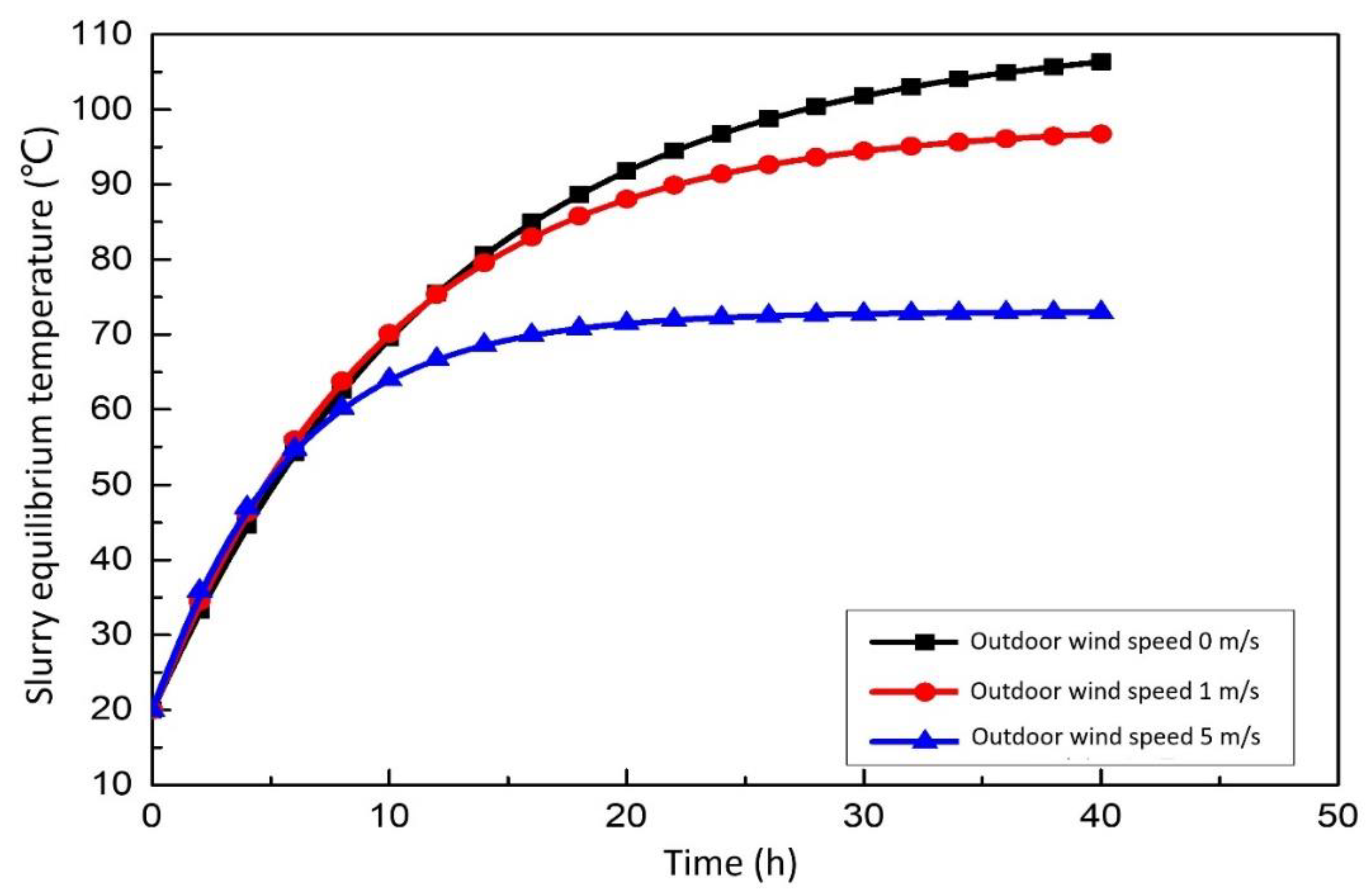


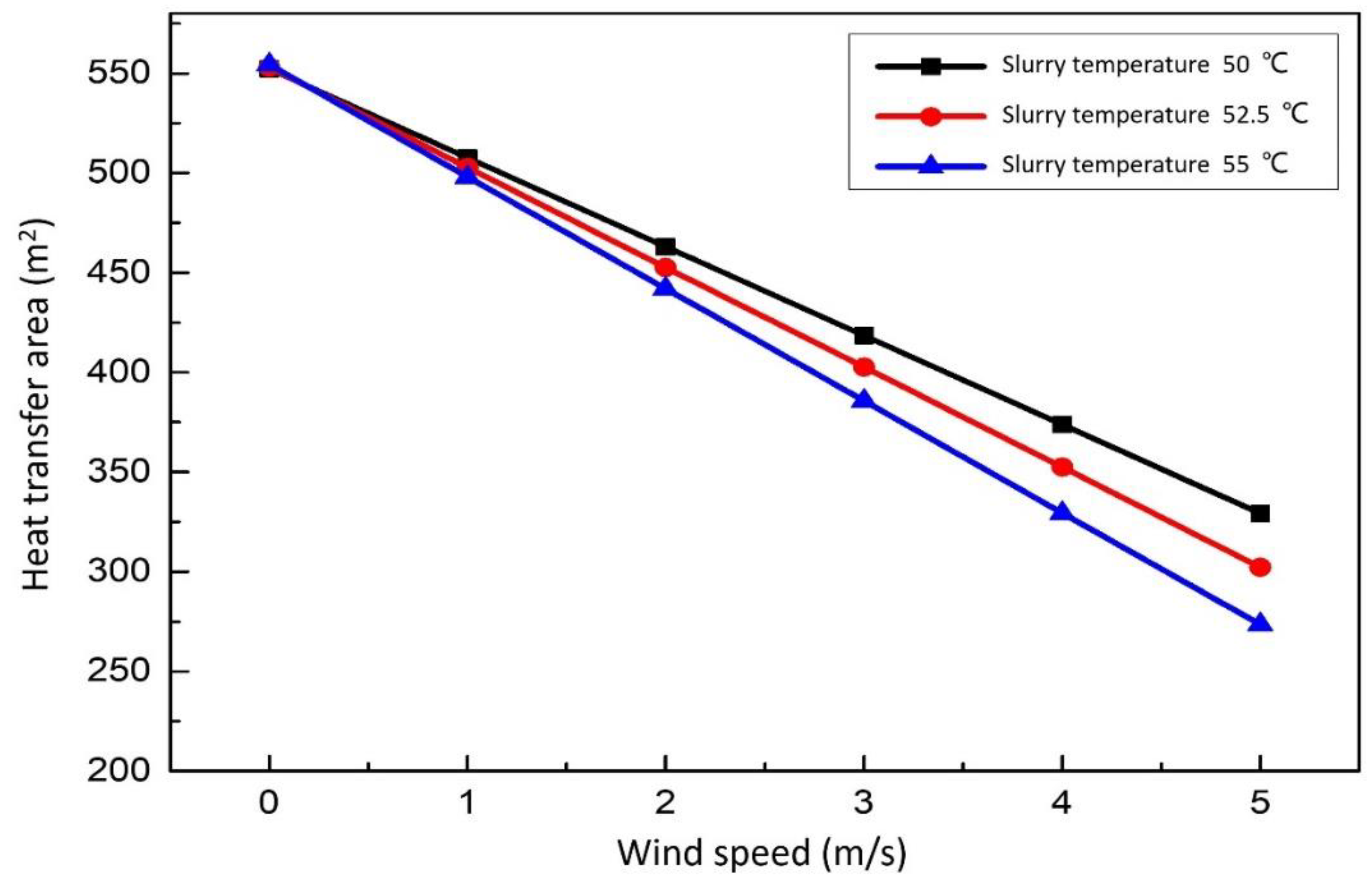
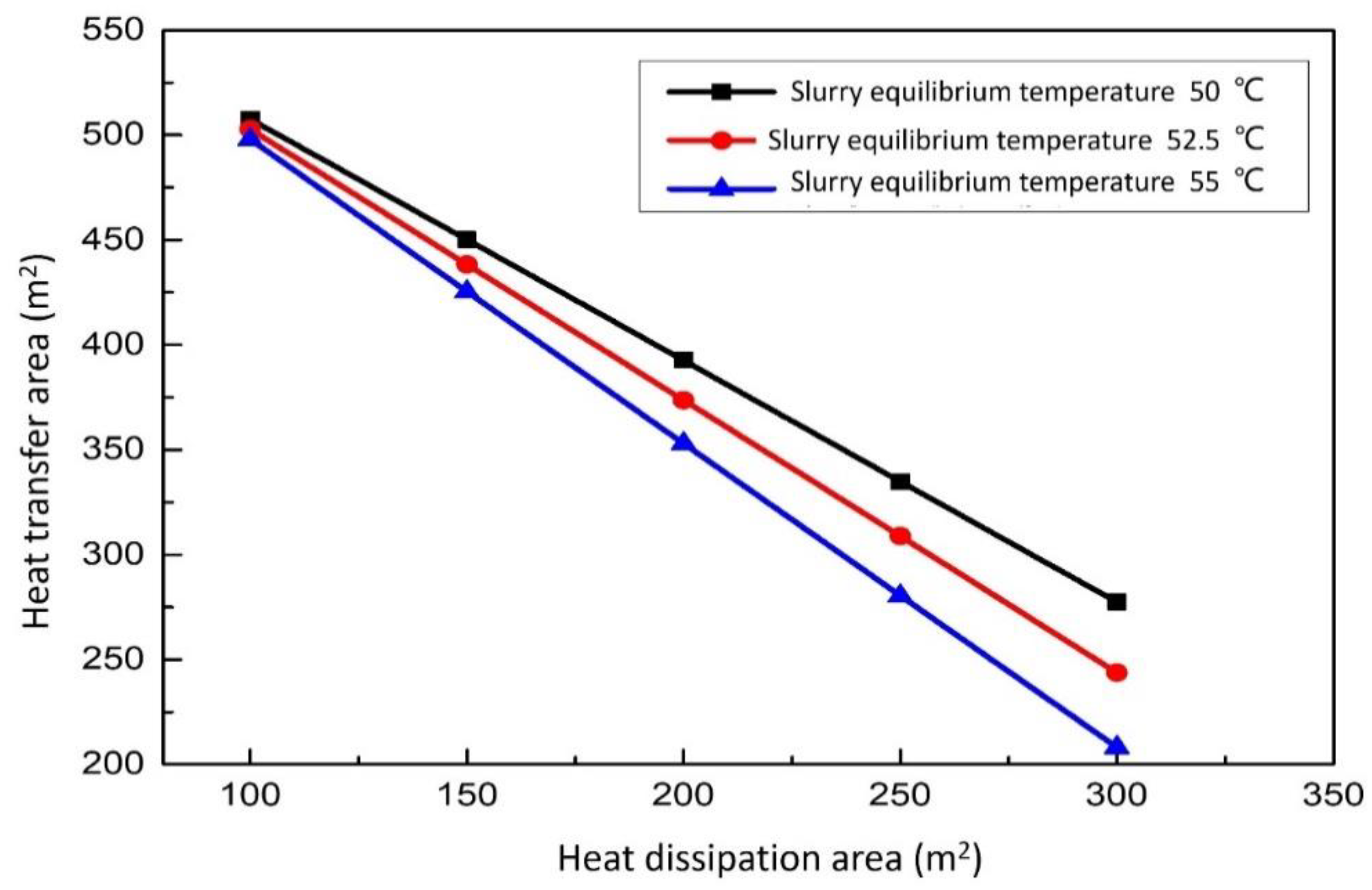

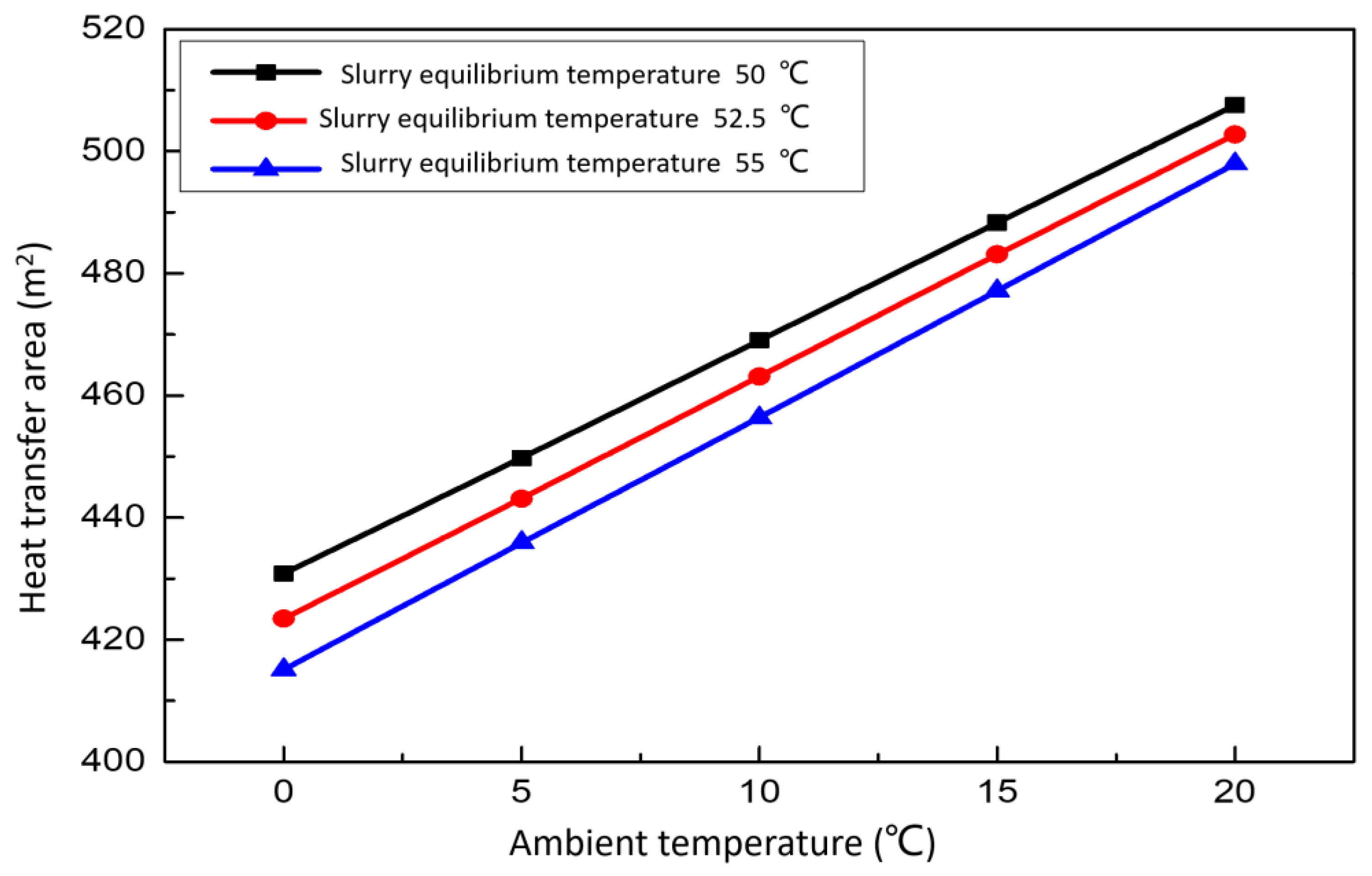
| Item | Value |
|---|---|
| Boiler parameters (t/h) | 50 |
| Coal burning quantity (t/h) | 8 |
| Flue gas volume (Nm3/h) | 110,000 |
| Desulfurizer concentration (%) | 0.15 |
| Desulfurizer density (kg/m3) | 1100 |
| Sulfur dioxide mass concentration (mg/m3) | 827 |
| Flue gas moisture content (kg/kg) | 0.05 |
| Mg–S ratio | 3.3 |
| Liquid–gas ratio | 1.67 |
| Air excess factor | 1.6 |
| Flue gas velocity (m/s) | 4 |
| Flue gas temperature (°C) | 165 |
| Droplet velocity (m/s) | 5 |
| Droplet temperature (°C) | 45 |
| Reaction zone length (m) | 4.5 |
| Item | Value | ||||
|---|---|---|---|---|---|
| Reaction zone height (m) | 0 | 1 | 2 | 3 | 4 |
| 1 | 1.0222 | 1.0444 | 1.0666 | 1.0888 | |
| 30 | 35 | 40 | 45 | 50 | |
| 1.0024 | 0.87666 | 0.75176 | 0.62554 | 0.498 | |
| Item | Flue Gas | Secondary Water |
|---|---|---|
| Inlet temperature (°C) | 165 | 45 |
| Outlet temperature (°C) | 121 | 50 |
| Flow (m3/h) | 110,925 | 200 |
| Velocity of flow (m/s) | - | 1.81 |
| Pipe diameter | - | DN200 |
| Item | Value |
|---|---|
| Heat exchanger (Ten thousand yuan/m2) | 0.15 |
| Heat exchanger area (m2) | 550 |
| Instrument pump pipeline (Ten thousand yuan) | 21 |
| Civil engineering installation (Ten thousand yuan) | 25 |
| Cover plate (Ten thousand yuan) | 4 |
| Tax revenue (Ten thousand yuan) | 15.63 |
| Total (Ten thousand yuan) | 148.13 |
| Item | Value |
|---|---|
| Operating time (h/year) | 4380 |
| Conversion price of calorific value (yuan/GJ) | 40 |
| Heat recovery efficiency (%) | 80 |
| Saving energy (kW) | 1461 |
| Total (Ten thousand yuan) | 73.7 |
Publisher’s Note: MDPI stays neutral with regard to jurisdictional claims in published maps and institutional affiliations. |
© 2021 by the authors. Licensee MDPI, Basel, Switzerland. This article is an open access article distributed under the terms and conditions of the Creative Commons Attribution (CC BY) license (https://creativecommons.org/licenses/by/4.0/).
Share and Cite
Zhang, C.; Zou, D.; Huang, X.; Lu, W. Coal-Fired Boiler Flue Gas Desulfurization System Based on Slurry Waste Heat Recovery in Severe Cold Areas. Membranes 2022, 12, 47. https://doi.org/10.3390/membranes12010047
Zhang C, Zou D, Huang X, Lu W. Coal-Fired Boiler Flue Gas Desulfurization System Based on Slurry Waste Heat Recovery in Severe Cold Areas. Membranes. 2022; 12(1):47. https://doi.org/10.3390/membranes12010047
Chicago/Turabian StyleZhang, Chenghu, Dezhi Zou, Xinpeng Huang, and Weijun Lu. 2022. "Coal-Fired Boiler Flue Gas Desulfurization System Based on Slurry Waste Heat Recovery in Severe Cold Areas" Membranes 12, no. 1: 47. https://doi.org/10.3390/membranes12010047





